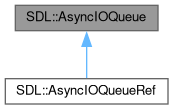A queue of completed asynchronous I/O tasks. More...
Inheritance diagram for SDL::AsyncIOQueue:

Public Member Functions | |
| constexpr | AsyncIOQueue (const AsyncIOQueueRaw resource) |
| Constructs from AsyncIOQueueParam. More... | |
| constexpr | AsyncIOQueue (const AsyncIOQueue &other)=delete |
| Copy constructor. | |
| constexpr | AsyncIOQueue (AsyncIOQueue &&other) |
| Move constructor. | |
| constexpr | AsyncIOQueue (const AsyncIOQueueRef &other)=delete |
| constexpr | AsyncIOQueue (AsyncIOQueueRef &&other)=delete |
| AsyncIOQueue () | |
| Create a task queue for tracking multiple I/O operations. More... | |
| ~AsyncIOQueue () | |
| Destructor. | |
| AsyncIOQueue & | operator= (AsyncIOQueue other) |
| Assignment operator. | |
| constexpr AsyncIOQueueRaw | get () const |
| Retrieves underlying AsyncIOQueueRaw. | |
| constexpr AsyncIOQueueRaw | release () |
| Retrieves underlying AsyncIOQueueRaw and clear this. | |
| constexpr auto | operator<=> (const AsyncIOQueue &other) const =default |
| Comparison. | |
| constexpr bool | operator== (std::nullptr_t _) const |
| Comparison. | |
| constexpr | operator bool () const |
| Converts to bool. | |
| constexpr | operator AsyncIOQueueParam () const |
| Converts to AsyncIOQueueParam. | |
| void | Destroy () |
| Destroy a previously-created async I/O task queue. More... | |
| std::optional< AsyncIOOutcome > | GetResult () |
| Query an async I/O task queue for completed tasks. More... | |
| std::optional< AsyncIOOutcome > | WaitResult (Milliseconds timeout) |
| Block until an async I/O task queue has a completed task. More... | |
| std::optional< AsyncIOOutcome > | WaitResult () |
| Block until an async I/O task queue has a completed task. More... | |
| void | Signal () |
| Wake up any threads that are blocking in AsyncIOQueue.WaitResult(). More... | |
Detailed Description
When starting an asynchronous operation, you specify a queue for the new task. A queue can be asked later if any tasks in it have completed, allowing an app to manage multiple pending tasks in one place, in whatever order they complete.
- Since
- This struct is available since SDL 3.2.0.
- See also
- AsyncIOQueue.AsyncIOQueue
- AsyncIO.Read
- AsyncIO.Write
- AsyncIOQueue.GetResult
- AsyncIOQueue.WaitResult
- Category:
- Resource
Constructor & Destructor Documentation
◆ AsyncIOQueue() [1/2]
|
inlineexplicitconstexpr |
- Parameters
-
resource a AsyncIOQueueRaw to be wrapped.
This assumes the ownership, call release() if you need to take back.
◆ AsyncIOQueue() [2/2]
|
inline |
Async I/O operations are assigned to a queue when started. The queue can be checked for completed tasks thereafter.
- Postcondition
- a new task queue object or nullptr if there was an error; call GetError() for more information.
- Thread safety:
- It is safe to call this function from any thread.
- Since
- This function is available since SDL 3.2.0.
The documentation for this class was generated from the following file:
- SDL3pp/SDL3pp_asyncio.h